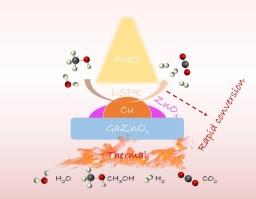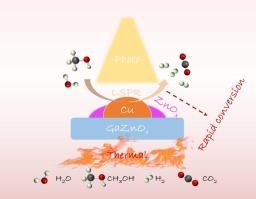Harnessing light to facilitate methanol conversion for high-efficiency hydrogen production under mild conditions
IF 6.5
1区 化学
Q2 CHEMISTRY, PHYSICAL
引用次数: 0
Abstract
For hydrogen storage applications, methanol serves as an ideal medium that effectively addresses storage and transportation challenges based on methanol steam reforming (MSR), which requires high temperatures (> 250 °C). Metal nanoparticles (e.g., Cu) with a localized surface plasmon resonance (LSPR) effect can utilize light to generate hot carriers for chemical reactions. Herein, the as-prepared Ga-doped CuZn catalyst (CuZn10Ga) achieves an exceptional H2 production rate of 243.1 ± 4.7 mmol·g−1·h−1 with near-perfect CO2 selectivity (99.9 %) and negligible CO selectivity (0.1 %), while maintaining excellent stability over 150 h under mild conditions (190 °C, 500 mW·cm−2). Detailed experimental studies reveal that Ga induced strong metal-support interactions (SMSI) in the CuZn10Ga, creating a high density of Cu-ZnOx interfacial active sites. Under photo-thermal conditions (190 °C, 500 mW·cm−2), light enhances both methoxy (*OCH3) conversion and formate (*HCOO) decomposition efficiency, as verified by catalytic experiments and in situ DRIFTS. This work offers valuable insights into the precise design of noble-metal-free active sites and the development of low-temperature activation technologies.


利用光促进甲醇转化,在温和条件下高效制氢
对于储氢应用,甲醇是一种理想的介质,可以有效地解决基于甲醇蒸汽重整(MSR)的储存和运输挑战,这需要高温(> 250 °C)。具有局部表面等离子体共振(LSPR)效应的金属纳米粒子(例如Cu)可以利用光产生化学反应的热载子。在此,制备的ga掺杂CuZn催化剂(CuZn10Ga)的H2产率为243.1 ± 4.7 mmol·g−1·h−1,具有近乎完美的CO2选择性(99.9 %)和可忽略的CO选择性(0.1 %),同时在温和条件下(190 °C, 500 mW·cm−2)在150 h以上保持优异的稳定性。详细的实验研究表明,Ga在CuZn10Ga中诱导了强金属支撑相互作用(SMSI),形成了高密度的Cu-ZnOx界面活性位点。在光热条件下(190 °C, 500 mW·cm−2),光提高了甲氧基(*OCH3)转化和甲酸(*HCOO)分解效率,这得到了催化实验和原位DRIFTS的验证。这项工作为无贵金属活性位点的精确设计和低温活化技术的发展提供了有价值的见解。
本文章由计算机程序翻译,如有差异,请以英文原文为准。
求助全文
约1分钟内获得全文
求助全文
来源期刊

Journal of Catalysis
工程技术-工程:化工
CiteScore
12.30
自引率
5.50%
发文量
447
审稿时长
31 days
期刊介绍:
The Journal of Catalysis publishes scholarly articles on both heterogeneous and homogeneous catalysis, covering a wide range of chemical transformations. These include various types of catalysis, such as those mediated by photons, plasmons, and electrons. The focus of the studies is to understand the relationship between catalytic function and the underlying chemical properties of surfaces and metal complexes.
The articles in the journal offer innovative concepts and explore the synthesis and kinetics of inorganic solids and homogeneous complexes. Furthermore, they discuss spectroscopic techniques for characterizing catalysts, investigate the interaction of probes and reacting species with catalysts, and employ theoretical methods.
The research presented in the journal should have direct relevance to the field of catalytic processes, addressing either fundamental aspects or applications of catalysis.
 求助内容:
求助内容: 应助结果提醒方式:
应助结果提醒方式:


